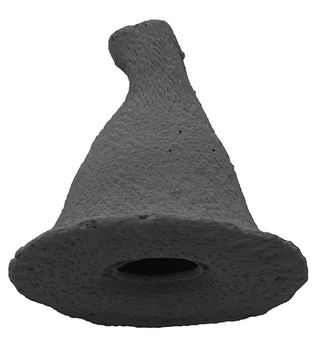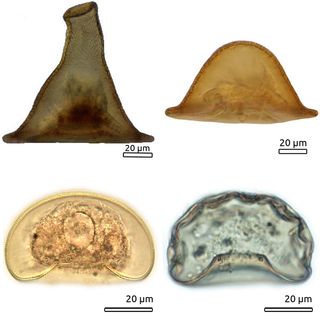Newfound Amoeba Looks Just Like Gandalf the Wizard's Hat

A newfound amoeba species whose funnel-shaped shell resembles a wizard's hat has been named after one of the most famous warlocks: Gandalf, of J.R.R. Tolkien's "The Lord of the Rings" trilogy.
The blob-like aquatic creature now goes by the scientific name Arcella gandalfi.
"New amoeba species are very rarely discovered because they're so tiny and not widely studied," study principal investigator Daniel J. G. Lahr, an assistant professor of zoology at the University of São Paulo in Brazil, said in a statement.
Most amoebae are single-celled organisms that sort of crawl to get around. The newly identified A. gandalfi is a camoeba, a type of amoeba that can create a carapacearound its soft body. [Extreme Life on Earth: 8 Bizarre Creatures]
The discovery occurred after Lahr began receiving reports of the amoeba's existence in bodies of freshwater in the Brazilian states of Minas Gerais, Tocantins, Paraná and Amapá, and the city of Rio de Janeiro.
However, the specimens from these regions were so small, it was nearly impossible to examine their anatomy and determine whether they belonged to a new species, Lahr said.
Luckily, Lahr got a little help from a friend — Jordana de Carvalho e Féres, a biologist who works for an environmental consultant firm in Espírito Santo. She had a sample from Rio de Janeiro with 180 specimens and another sample from Amapá, and said she could use her expertise in identifying zooplankton, tiny free-floating marine organisms, to help classify the new critter.
Sign up for the Live Science daily newsletter now
Get the world’s most fascinating discoveries delivered straight to your inbox.
The two agreed to study the amoeba in Lahr's lab in São Paulo, where they could use advanced microscopy and partner with other university researchers.
"We succeeded in isolating the organism from the samples, performed all [of] the necessary measurements and produced images to make sure it really was a new species," Lahr said.
In the end, they found that the funnel shape of A. gandalfi was unique in the genus Arcella, one of the largest groups of amoebaewith carapaces that grow in wetlands, damp soils and bogs, he said.

Hats off
A. gandalfi is an itty-bitty creature. It ranges in color from light yellow to brown, and its carapace has a diameter of 0.0032 inches (81 micrometers) and a height of 0.0028 inches (71 micrometers).
Despite its minute size, A. gandalfi is considered large for a single-celled organism, especially one in the genus Arcella. There are about 200 Arcella species, and most are half that size. "It's just one cell, and yet it's capable of building this funnel-shaped carapace," Lahr said.
It appears that A. gandalfi lives only in South America, he said. The amoeba is so unique that he and his colleagues are calling it a flagship species — a key species for a habitat that can serve as an icon of an environmental cause, just as the polar bear has become a symbol for climate change.
However, despite the amoeba's exceptional "wizard's hat" carapace, it's not clear why A. gandalfi, — or other amoebae, for that matter — make carapaces. One idea is that amoebae make these structures to protect themselves against predators. [5 Key Facts About Brain-Eating Amoeba]
But Lahr said he doesn't find this idea convincing. "The camoebians are strongly predated, and we often find their carapaces ingested by a class of protozoans called ciliates, for example," he said. "For these microorganisms, the shell is not protective like armor plating, as it is in the case of arthropods [such as insects and arachnids], which are preyed on by animals of the same size."
Rather, the carapace might protect against dryness. These amoebae are often left high and dry when water levels fluctuate, and the carapace likely helps them stay moist, Lahr said.
"We think they're able to maintain a humid microenvironment inside the shell when it's dry outside, by storing even a tiny amount of water," Lahr said.

The carapace might also shield the creature from ultraviolet (UV) radiation.
"Their habitats are aquatic, and they're often exposed to sunlight, so protection against UV rays must be a very important factor," Lahr noted. "A multicellular organism has a number of protective barriers against UV radiation, including a layer of keratin, as well as skin pigments. In the case of single-cell organisms like amoebae, their DNA is basically exposed."
The newly identified organism isn't the only new creature that looks like a hat. In December 2016, researchers formally gave a hat-shaped spider the name Eriovixia gryffindori, because it looked like the Sorting Hat from J.K. Rowling's "Harry Potter" series.
The findings were published online in December 2016 in the journal Acta Protozoologica.
Original article on Live Science.

Laura is the archaeology and Life's Little Mysteries editor at Live Science. She also reports on general science, including paleontology. Her work has appeared in The New York Times, Scholastic, Popular Science and Spectrum, a site on autism research. She has won multiple awards from the Society of Professional Journalists and the Washington Newspaper Publishers Association for her reporting at a weekly newspaper near Seattle. Laura holds a bachelor's degree in English literature and psychology from Washington University in St. Louis and a master's degree in science writing from NYU.
Most Popular


